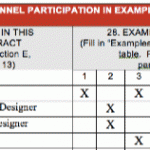I hear it all the time. I’m sure you do as well.
“Oh, we lost that one on price.”
Let me explain why that’s not always true. And I’ll provide you a simple rule of thumb to determine when you’ve lost due to your best value price and when you could have done more to help your client justify going with your higher price.
A Common Price Misconception
A common misconception is that it’s all about price. If someone underbids you, you’ve lost the contract.
But here’s a reality check.
- Yes, price does matter
- But if a client can justify going with a higher price, they often will
Beware This Go-To False Assumption
A few years ago, I met with the Vice President of a large construction management (CM) firm. To his surprise, I pulled out one of their proposals and walked him through the problems with it. I made some suggestions regarding how to make their offering more compelling.
His response was something I commonly hear, “We lost that one on price.”
That’s far too often a “go to” response when you lose in a best-value situation.
You see, he was wrong. And I had the proof. Clients often have to justify their selection decisions in writing. In this instance, I had possession of all the bids and the justification documentation.
The justification document and bids told a different story. In fact, the contract was not awarded to the lowest price bid.
And the justification document outlined why the client chose the winner. Ironically, the justification closely matched my assessment of what could be improved with the firm’s offering.
The justification made total sense. Yes, the winning firm’s price was slightly lower than this CM’s. But it was not the lowest bid.
You see, the winner had two things going for it:
- Its price was within the 5-10-20 rule of thumb for price.
- They were able to provide a very convincing justification why the client should choose their higher price.
Before we dig into the 5-10-20 Rule, let’s go over the common selection methods you’ll see.
The Four Selection Types
In general, there are four methods clients use to award contracts.
- Low Bid: Where they take the lowest bid, regardless of who the bid is from.
- Lowest Priced Technically Acceptable Bid: This is where they evaluate proposals based on predetermined pass/fail criteria and then select the lowest price from the group that passed.
- Best Value: This is the most common selection method. This is where clients will evaluate several factors, including price. In this method, price cannot be the sole factor. This is sometimes referred to as a “Brooks Act” or “trade-off” approach.
- Negotiated or Qualifications-Based Selection: This is when a client selects solely based on non-price factors. Then they’ll negotiate a price with the highest-rated firm. If they can’t come to an agreement, they just negotiate with the next highest-rated firm.
Clearly, best-value procurements are the trickiest because price is evaluated along with other factors. It’s also the most common approach many of us see.
Luckily, there’s a simple rule of thumb to help you determine whether or not you could have done more to convince the client to go with your higher price.
The 5-10-20 Best Value Price Rule
The 5-10-20 Rule is a tool to help you determine whether you truly lost on price. In some cases, it can help inform your price decisions.
Here’s how it works.
In very price sensitive situations, you want your price to fall within 5% of the lowest accepted proposal. As your price moves further from that 5% benchmark, it gets increasingly difficult for a client to justify selecting your firm.
In moderately price sensitive situations, ones where other factors play a major role, you’ll need to land within 10% of the lowest technically acceptable price before it gets really tough for clients to justify selecting you.
In situations where price is not among the most critical factors, even when you’re the “preferred vendor,” price can still play a role. In these cases, a price 20% higher than the lowest technically acceptable offer is going to make it hard for a client to justify selecting you. And as you reach 50% higher, it might become impossible for your client to select you for the contract.
Using The 5-10-20 Best Value Price Rule
Remember, as you move further and further away from these price benchmarks, it becomes more and more difficult for clients to select you.
That doesn’t mean it’s impossible. And I’m sure there have been situations where firms won best value procurements when their price was 50% higher than the lowest technically acceptable price. I’m sure it has happened at least one. But I’m also sure it hasn’t happened one thousand times.
And even in the most price sensitive, best value, procurement, if your bid was within 5% of the lowest price, the reason you lost was your case wasn’t compelling enough.
The 5-10-20 Rule is simply a tool to help you assess how difficult your price made it to select you.
Now It’s Your Turn
What rules of thumb have you used for pricing? Share with us in the comments.





Speak Your Mind